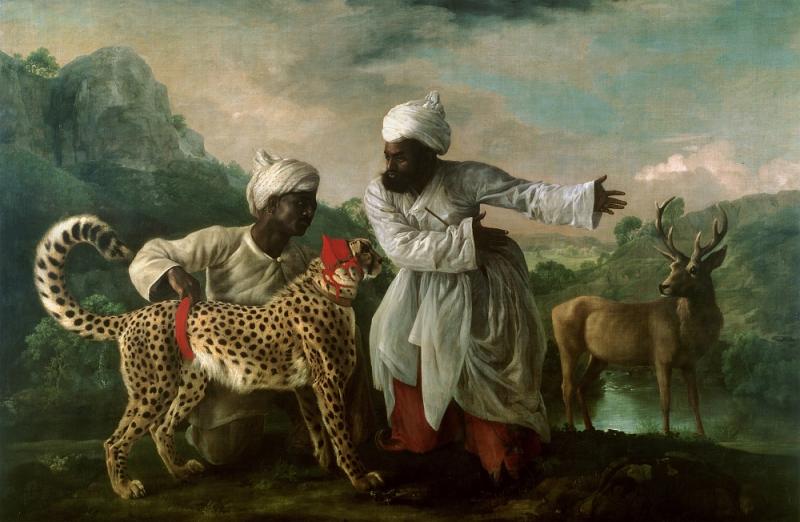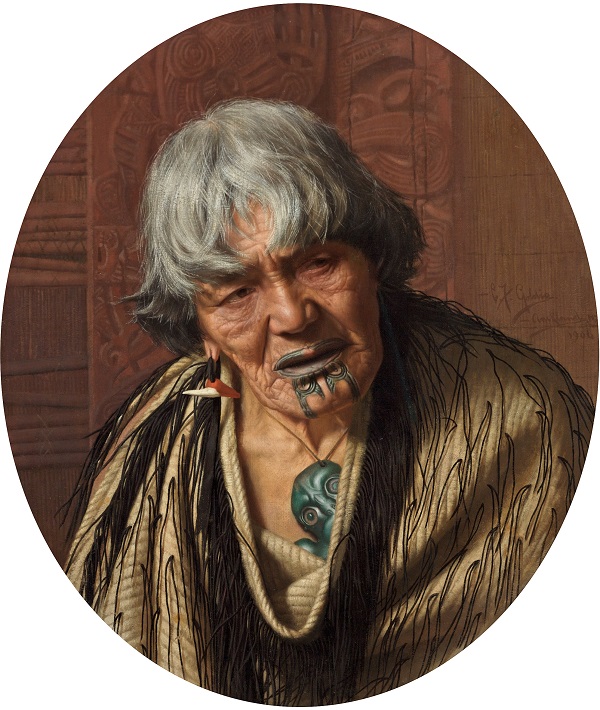Artist and Empire, Tate Britain | reviews, news & interviews
Artist and Empire, Tate Britain
Artist and Empire, Tate Britain
An ambitious survey that fails to do justice to a vast and complex subject

There are some wonderful things in this exhibition, and that’s no surprise: the British Empire endured for over 500 years and at its peak extended across a quarter of the world’s land mass. Preparing an exhibition of corresponding reach must have involved considering a vast range of objects, but choosing well is another matter entirely.
So it is that the first room, devoted to maps and map-making, feels like a statement of intent, getting in its condemnation of the British in advance of the many paintings we are about to see that glorify them. Crucial as they are to the business of empire-building, these maps are also raw representations of conquest, serving not only a practical purpose but an ideological one. It was through maps that indigenous place names were brutally and formally erased, and they provided a cheap and easily distributed means of hammering home the might of the British Empire across the globe, in schools, public buildings, homes and offices. Maps can be beautiful things, but here they act rather like a visual disclaimer for what is to follow.
 You can see exactly why such a caveat might have seemed necessary the moment you step foot in the next room, which bursts with glorious, exotic riches pillaged from far-flung lands. Centuries on, it is all still rather close to the bone, for in this dazzling array of botanical drawings and collected drawings is the same spirit that has shaped so many of our museum collections. Stubbs’ A Cheetah and a Stag and Two Indian Attendants, c. 1764, on loan from Manchester Art Gallery, is the crowning glory, and encapsulates the sense of wonder and excitement of the British at the expansion of the Empire (main picture).
You can see exactly why such a caveat might have seemed necessary the moment you step foot in the next room, which bursts with glorious, exotic riches pillaged from far-flung lands. Centuries on, it is all still rather close to the bone, for in this dazzling array of botanical drawings and collected drawings is the same spirit that has shaped so many of our museum collections. Stubbs’ A Cheetah and a Stag and Two Indian Attendants, c. 1764, on loan from Manchester Art Gallery, is the crowning glory, and encapsulates the sense of wonder and excitement of the British at the expansion of the Empire (main picture).
One of the most impressive, but simultaneously shocking rooms deals with history paintings made to commemorate and glorify British conquests overseas. For the most part these paintings serve to add a veneer of British decency to episodes of barbarity, and in Robert Home’s The Reception of the Mysorean Hostage Princes by Marquis Cornwallis, 26 February 1792, c.1793, the British soldiers taking two little boys prisoner appear as amiable as kindly uncles. In shocking contrast is Edward Armitage’s vast painting Retribution, 1858, in which a fearsome Britannia slays a Bengal tiger. It was meant to hang in Leeds Town Hall, intended to stir up the vengeful anger of the British in response to the Cawnpore Massacre of 1857, in which over 100 British women and children were murdered.
As the Empire matured, relations between colonist and colonised inevitably became more complex, and the second half of the exhibition struggles in vain to address and represent the different encounters and narratives of Britain’s colonial past. While the first rooms have a coherence that comes from presenting art from within the same western tradition, the multiple and varied cultures of the colonies can only be inadequately represented. At its height, the British Empire was so vast and the people within it so diverse that the attempt could hardly be anything but tokenistic.
 Nevertheless, some fascinating examples of the mingling of western and indigenous artistic traditions emerge, the carved figure of Queen Victoria made by a Yoruba artist in Nigeria, combining traditional wood-carving techniques with western portraiture (Pictured above right), while the European taste for romanticised portraiture found new, exotic subjects in the colonies (Pictured left: Charles Frederick Goldie, Harata Rewiri Tarapata: A Maori Chieftainess, 1906).
Nevertheless, some fascinating examples of the mingling of western and indigenous artistic traditions emerge, the carved figure of Queen Victoria made by a Yoruba artist in Nigeria, combining traditional wood-carving techniques with western portraiture (Pictured above right), while the European taste for romanticised portraiture found new, exotic subjects in the colonies (Pictured left: Charles Frederick Goldie, Harata Rewiri Tarapata: A Maori Chieftainess, 1906).
Like almost every topic addressed here, the attempt to summarise the impact of non-western art on European artists in the 20th century really merits its own exhibition, while the examination of the legacies of empire would feel incredibly truncated were one actually capable of looking at anything more. This is an ambitious show that has overstretched itself; by trying to fairly represent every aspect of this long and complicated episode in world history, the whole endeavour lacks the gravitas it deserves.
rating
Explore topics
Share this article
The future of Arts Journalism
You can stop theartsdesk.com closing!
We urgently need financing to survive. Our fundraising drive has thus far raised £33,000 but we need to reach £100,000 or we will be forced to close. Please contribute here: https://gofund.me/c3f6033d
And if you can forward this information to anyone who might assist, we’d be grateful.

Subscribe to theartsdesk.com
Thank you for continuing to read our work on theartsdesk.com. For unlimited access to every article in its entirety, including our archive of more than 15,000 pieces, we're asking for £5 per month or £40 per year. We feel it's a very good deal, and hope you do too.
To take a subscription now simply click here.
And if you're looking for that extra gift for a friend or family member, why not treat them to a theartsdesk.com gift subscription?
more Visual arts
 Help to give theartsdesk a future!
Support our GoFundMe appeal
Help to give theartsdesk a future!
Support our GoFundMe appeal
 Ed Atkins, Tate Britain review - hiding behind computer generated doppelgängers
Emotions too raw to explore
Ed Atkins, Tate Britain review - hiding behind computer generated doppelgängers
Emotions too raw to explore
 Echoes: Stone Circles, Community and Heritage, Stonehenge Visitor Centre review - young photographers explore ancient resonances
The ancient monument opens its first exhibition of new photography
Echoes: Stone Circles, Community and Heritage, Stonehenge Visitor Centre review - young photographers explore ancient resonances
The ancient monument opens its first exhibition of new photography
 Hylozoic/Desires: Salt Cosmologies, Somerset House and The Hedge of Halomancy, Tate Britain review - the power of white powder
A strong message diluted by space and time
Hylozoic/Desires: Salt Cosmologies, Somerset House and The Hedge of Halomancy, Tate Britain review - the power of white powder
A strong message diluted by space and time
 Mickalene Thomas, All About Love, Hayward Gallery review - all that glitters
The shock of the glue: rhinestones to the ready
Mickalene Thomas, All About Love, Hayward Gallery review - all that glitters
The shock of the glue: rhinestones to the ready
 Interview: Polar photographer Sebastian Copeland talks about the dramatic changes in the Arctic
An ominous shift has come with dark patches appearing on the Greenland ice sheet
Interview: Polar photographer Sebastian Copeland talks about the dramatic changes in the Arctic
An ominous shift has come with dark patches appearing on the Greenland ice sheet
 Donald Rodney: Visceral Canker, Whitechapel Gallery review - absence made powerfully present
Illness as a drive to creativity
Donald Rodney: Visceral Canker, Whitechapel Gallery review - absence made powerfully present
Illness as a drive to creativity
 Noah Davis, Barbican review - the ordinary made strangely compelling
A voice from the margins
Noah Davis, Barbican review - the ordinary made strangely compelling
A voice from the margins
 Best of 2024: Visual Arts
A great year for women artists
Best of 2024: Visual Arts
A great year for women artists
 Electric Dreams: Art and Technology Before the Internet, Tate Modern review - an exhaustive and exhausting show
Flashing lights, beeps and buzzes are diverting, but quickly pall
Electric Dreams: Art and Technology Before the Internet, Tate Modern review - an exhaustive and exhausting show
Flashing lights, beeps and buzzes are diverting, but quickly pall
 ARK: United States V by Laurie Anderson, Aviva Studios, Manchester review - a vessel for the thoughts and imaginings of a lifetime
Despite anticipating disaster, this mesmerising voyage is full of hope
ARK: United States V by Laurie Anderson, Aviva Studios, Manchester review - a vessel for the thoughts and imaginings of a lifetime
Despite anticipating disaster, this mesmerising voyage is full of hope

Add comment